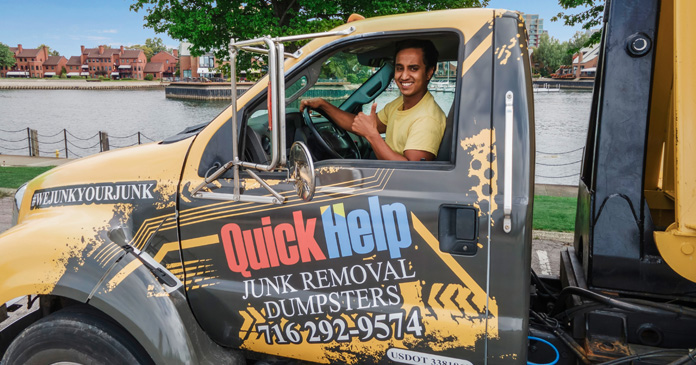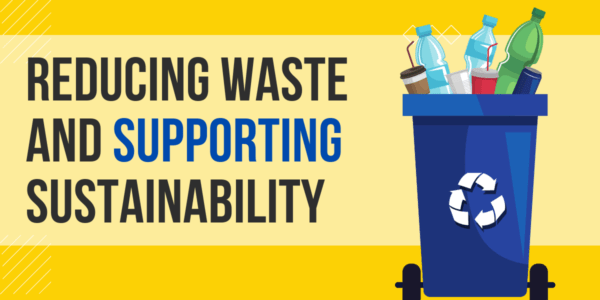Ever walk into your home and feel a wave of overwhelm just looking at all your stuff? You’re not alone. The average American has over 300,000 items in their house. Yeah, you read that right—300,000 things taking up space in your life.
I’m about to show you exactly how to recognize when your home is crying for a declutter session and the simple places to start without feeling like you’re tackling Mount Everest.
Knowing when it’s time to declutter your home isn’t just about aesthetics—it’s about reclaiming your mental space too. When was the last time you actually felt relaxed in your living room?
Let me guess: you’ve tried organizing before, but something always held you back. That “something” might be exactly what we need to address first…
Signs It’s Time to Declutter

Physical Signs of Clutter Overload
You know that moment when you can’t shut your closet door? That’s not just annoying—it’s your home waving a red flag. Piles on countertops that never seem to disappear, stuff balanced precariously on furniture, and those “temporary” storage boxes that have somehow become permanent fixtures—these are all screaming that clutter has taken over.
The most obvious sign? You’ve run out of places to put things, so new purchases end up on chairs, floors, or any flat surface available.
Emotional Stress Triggered by Your Space
Ever walk into your home and immediately feel your shoulders tense up? That’s your body’s reaction to visual chaos. Clutter bombards your brain with excessive stimuli, forcing your senses to work overtime.
Many people report feeling anxious, overwhelmed, or even depressed when surrounded by too much stuff. If you find yourself avoiding certain rooms or feeling a wave of dread when looking at specific areas of your home, your clutter is messing with your mental health.
Difficulty Finding Important Items
“Has anyone seen my keys?” becomes your daily mantra when clutter takes over. If you’re constantly hunting for essentials—bills, documents, medication—you’re wasting precious time and adding unnecessary stress to your life.
When you buy duplicates because you can’t find the original item (only to discover three more after your purchase), that’s a clear signal it’s time to declutter.
Unused Items Taking Prime Real Estate
That treadmill-turned-clothes-hanger in your bedroom? The kitchen gadgets still in boxes after years? These unused items are stealing space from things you actually use.
If you’re keeping stuff “just in case” or because “it might be valuable someday,” you’re prioritizing hypothetical future scenarios over your current quality of life.
Embarrassment About Inviting People Over
Constantly making excuses to avoid hosting friends or family? If the thought of someone dropping by unexpectedly sends you into panic mode, your clutter has begun controlling your social life.
When you find yourself saying “Sorry about the mess” the moment anyone enters your home, or you’ve stopped inviting people altogether, it’s definitely time to reclaim your space.
The Mental and Physical Benefits of Decluttering
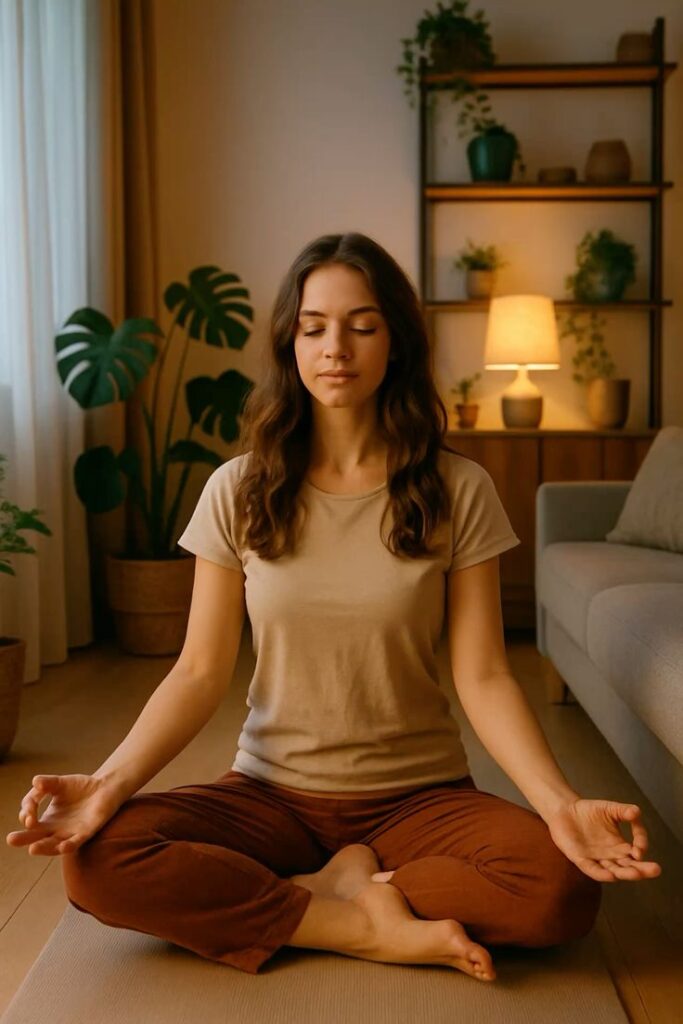
Reduced Anxiety and Stress
Ever noticed how a messy room makes your mind feel just as cluttered? That’s not a coincidence. When your space is overflowing with stuff, your brain is constantly processing all those visual stimuli, whether you realize it or not.
Think about that feeling when you walk into a clean hotel room. That immediate “ahh” sensation isn’t luxury—it’s relief. Your brain isn’t sorting through piles of laundry or stacks of mail.
Research shows that people with cluttered homes have higher cortisol levels throughout the day. That’s your stress hormone working overtime, folks. Decluttering literally lowers your biological stress response.
Improved Focus and Productivity
Your brain craves order more than you might think. When your workspace is clear, your ability to focus skyrockets.
A Princeton University study found that visual clutter competes for your attention, reducing your performance and increasing errors. Translation: that pile of random stuff in your peripheral vision is actually sabotaging your work.
I once cleared my desk completely except for my laptop and current project. My work time became so much more efficient that I finished tasks in half the usual time.
Better Sleep Quality
Your bedroom clutter might be keeping you up at night. And I’m not talking about physically bumping into things on your midnight bathroom trip.
People who sleep in cluttered rooms report poorer sleep quality and more sleep disturbances. Your brain associates your bedroom with rest—or with unfinished business when there’s visible clutter.
Enhanced Creativity
Creativity needs space to breathe. When your environment is jammed with things, there’s no room for new ideas to form.
Creative professionals often report breakthrough moments after clearing their spaces. With fewer visual distractions, your mind is free to make unexpected connections and develop fresh ideas.
Preparing Yourself for the Decluttering Process

Setting Realistic Goals and Timeframes
Decluttering isn’t a sprint—it’s more like a marathon with snack breaks. Most people crash and burn because they try to Marie Kondo their entire house in a weekend. Spoiler alert: that’s a recipe for frustration.
Start small. Really small. Like “I’m going to tackle this one kitchen drawer” small. Give yourself 15-30 minutes for that drawer and actually finish it. The win feels amazing, and suddenly you’re motivated to do another one tomorrow.
Break your home into zones rather than rooms. A bedroom closet is its own zone. Your bathroom cabinet? Another zone. This way, you can check off wins faster and avoid the dreaded half-decluttered room syndrome.
Set a timer. Work for 25 minutes, then take a 5-minute break. You’d be shocked how much you can accomplish in focused bursts.
Creating a Decluttering Mindset
The hardest part of decluttering isn’t the physical work—it’s the mental game. You need to rewire your brain a bit.
Ask yourself one question with everything you touch: “Would I buy this again today?” Not “might I need this someday” or “but it was expensive.” Those questions keep your clutter firmly in place.
Remember that empty space isn’t wasted space. It’s breathing room. It’s possibility. That counter doesn’t need to be filled with appliances you use twice a year.
Drop the guilt. That gift from Aunt Martha you never liked? It served its purpose the moment she gave it to you. The joy was in the giving, not in you storing it forever.
Gathering Necessary Supplies
You don’t need fancy containers or color-coded systems to start decluttering. That’s just another way to procrastinate. (And buy more stuff. Ironic, right?)
Grab these basics:
-
- Trash bags (heavy duty ones)
-
- Three boxes labeled: Keep, Donate, Relocate
-
- Sticky notes and a marker
-
- Your phone for quick “should I keep this?” research and donation lookups
Don’t waste money on storage solutions until AFTER you’ve decluttered. Most people buy bins that end up becoming clutter themselves.
Set up a “holding zone” somewhere in your home—maybe a corner of the garage or a closet. Place items you’re unsure about there with a date. If you haven’t needed it in 30 days, you have your answer.
Where to Start Your Decluttering Journey
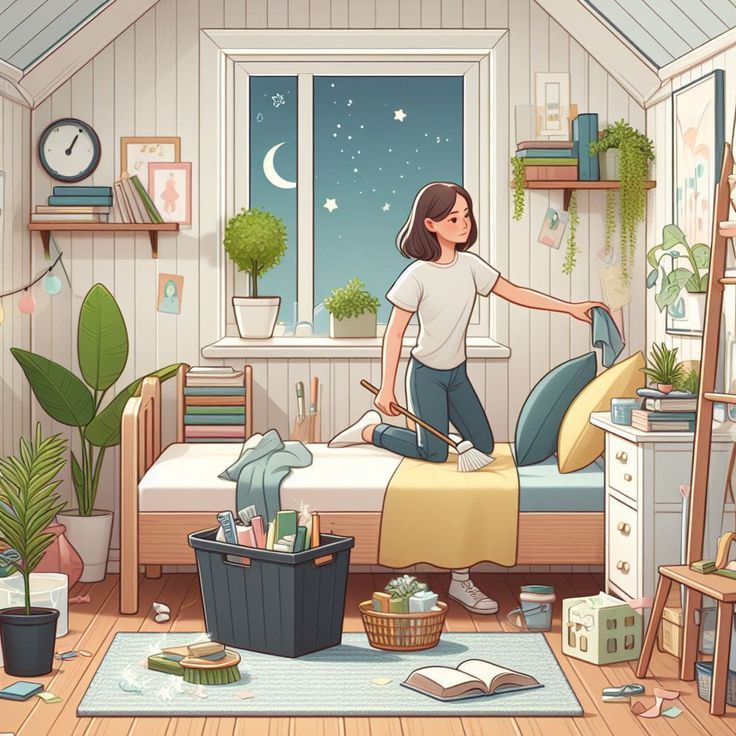
The 15-Minute Method for Overwhelmed Beginners
Feeling paralyzed by the mountain of stuff around you? Yeah, I get it. The 15-minute method is your new best friend.
Here’s the deal: set a timer for just 15 minutes. That’s it. Anyone can do anything for 15 minutes, right? Focus on one small area – maybe that kitchen counter that’s become a landing zone for everything from mail to random cables.
When the timer goes off, you’re done! No guilt, no pressure to continue. The beauty is that most people find once they start, they actually want to keep going. But if you don’t? That’s totally fine too.
Do this daily and watch how these small chunks add up. It’s like magic – suddenly that overwhelming mess becomes manageable bite by bite.
Tackling the Visible Hotspots First
You know those spots that drive you crazy every time you walk by? The overflowing coat rack, that chair piled with laundry, the entryway table drowning in random stuff?
Start there.
These visible hotspots create daily visual stress. They’re the clutter that scratches at your brain constantly, making your whole home feel messier than it might actually be.
Clearing these areas first gives you an immediate mood boost. You’ll feel like you’ve accomplished something major because the impact is so visible. It’s the decluttering equivalent of low-hanging fruit – maximum impact for minimal effort.
Plus, that visible change can be just the motivation kick you need to keep going with the less obvious spaces.
Starting with the Easiest Room
Not all rooms are created equal when it comes to decluttering difficulty. That’s why smart declutterers often start with the easiest room in the house.
What makes a room “easy”? It’s usually smaller, has less emotional baggage attached to its contents, and serves a straightforward purpose. Think bathroom or laundry room rather than basement or home office.
Tackling an easier room first lets you:
-
- Practice your decision-making muscles
-
- Develop a system that works for you
-
- Build confidence for the tougher spaces
-
- Enjoy a fully decluttered space faster
The momentum from completing one room can carry you through to the next challenge. Nothing motivates like success!
Beginning with Items You Never Use
Still not sure where to start? Look around for the obvious stuff – things you literally never use.
We all have them: the pasta maker still in its box from three Christmases ago, clothes with tags still attached, exercise equipment gathering dust, books you’ll “someday” read.
These are your easiest decluttering wins because deep down, you already know you don’t use or need them. No complex emotional decisions required.
Grab a box and walk through your home, collecting only the obvious never-used items. Don’t overthink it – if you haven’t touched it in a year and felt no lack, it’s a prime candidate.
This approach builds your decluttering confidence because the decisions are so clear-cut. Once you’ve cleared the obvious stuff, you’ll have both physical space and mental clarity to tackle the harder decisions.
Effective Sorting Strategies
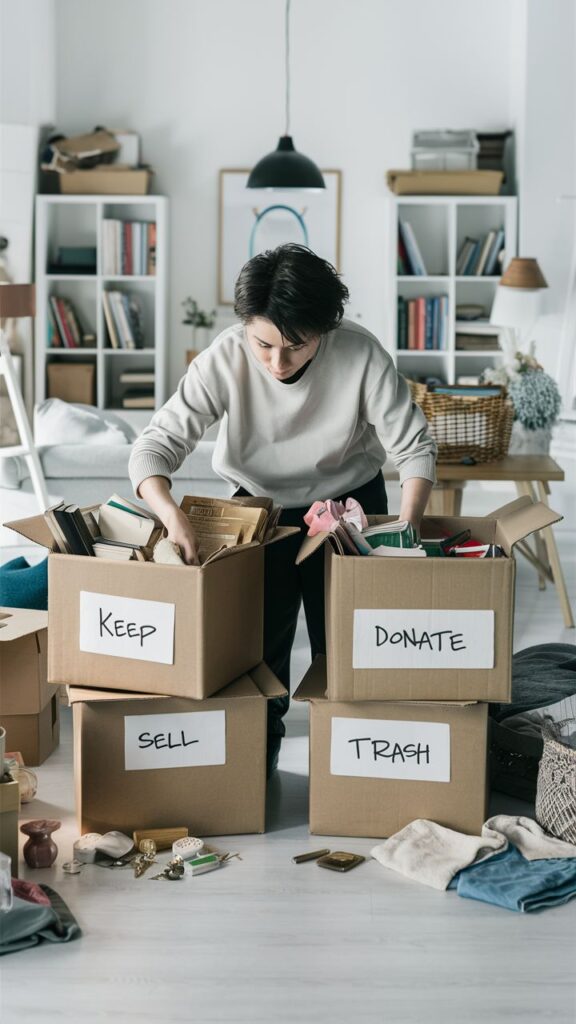
A. The Four-Box Method (Keep, Donate, Sell, Trash)
Drowning in stuff? The four-box method cuts through the chaos like nothing else. Grab four containers and label them: Keep, Donate, Sell, and Trash. Then tackle each item in your space with brutal honesty.
The “Keep” box is for things you actually use or truly love. Not “might use someday” or “used to love” – be ruthless here.
Your “Donate” box gives your unused items a second life. Someone else will appreciate that bread maker you used twice.
Got valuable items? The “Sell” box is your money-maker. Just don’t let it become a project that never happens.
The “Trash” box is for the broken, worn-out stuff you’ve been ignoring. If it’s beyond repair or donation, let it go.
B. The One-Year Rule for Questionable Items
On the fence about something? Try the one-year rule. If you haven’t used it in the past 12 months, you probably don’t need it.
This rule works like magic for seasonal items. Those holiday decorations you skipped last year? The camping gear collecting dust? That juicer from your health kick? Time to say goodbye.
The exceptions? Sentimental items and emergency supplies. But be honest—most questionable items aren’t either of these.
C. Decision-Making Questions to Ask Yourself
When you’re stuck, ask yourself these questions:
-
- “Would I buy this again today?”
-
- “If this disappeared tomorrow, would I replace it?”
-
- “Does this make my life better or easier?”
-
- “Is this worth the space it’s taking up?”
-
- “Am I keeping this out of guilt or obligation?”
The answers usually point to the right decision. Trust your gut.
D. Category-Based Versus Room-Based Approaches
Two paths to decluttering greatness:
Room-based decluttering tackles one space at a time. Great for quick wins and visible progress. Perfect if you’re short on time or easily overwhelmed.
Category-based decluttering (think Marie Kondo) means gathering ALL similar items from your entire home. All clothes, all books, all kitchen tools—then deciding what stays. This approach prevents duplicates and shows you exactly how much stuff you actually have.
Mix these approaches based on your personality and the mess at hand.
E. Digital Decluttering Techniques
Your digital life needs decluttering too. Start with your phone—delete unused apps and those thousands of random photos.
For your computer, create a system:
-
- Sort files into clearly labeled folders
-
- Delete duplicates and outdated documents
-
- Clear your desktop of random files
-
- Unsubscribe from email newsletters you never read
Back up what matters, then delete the digital weight dragging you down. Your devices will run faster, and you’ll find things when you need them.
Digital decluttering isn’t just about space—it’s about mental clarity.
Maintaining Your Clutter-Free Home

A. Daily 10-Minute Tidy-Up Routines
Ever notice how clutter seems to multiply overnight? That’s why I swear by the 10-minute daily tidy-up. It’s a game-changer.
Pick a consistent time—right after dinner works for most families. Set a timer for 10 minutes and focus on quick wins:
-
- Return items to their proper homes
-
- Clear kitchen counters
-
- Hang up clothes or put them in hampers
-
- Sort mail and toss junk immediately
The beauty of this approach? Nothing ever gets overwhelming. When my client Sarah started this habit, she told me: “I can’t believe how much difference 10 minutes makes. My mornings are completely different now.”
B. One-In-One-Out Shopping Rule
This rule is non-negotiable if you’re serious about staying clutter-free.
Before bringing any new item home, decide what’s leaving. Bought a new sweater? Time to donate one you haven’t worn in a year. New kitchen gadget? Say goodbye to one you rarely use.
This approach:
-
- Prevents accumulation creep
-
- Makes you think twice before impulse purchases
-
- Maintains the balance you worked so hard to achieve
I used to be a chronic shopper until I adopted this rule. Now I ask myself, “Do I love this enough to let something else go?” Usually, the answer is no.
C. Quarterly Reassessment Sessions
Mark your calendar for a deep dive every three months.
Block off 2-3 hours to:
-
- Revisit problem areas that tend to collect clutter
-
- Evaluate seasonal items no longer needed
-
- Check if your organizational systems are still working
What seemed like a perfect storage solution in January might not make sense by April. Your needs change, and your systems should too.
During these sessions, be honest with yourself. That craft project you haven’t touched in six months? The exercise equipment collecting dust? Maybe it’s time to admit they don’t deserve the space they’re taking.

Recognizing the signs of clutter overload and taking decisive action can transform both your living space and overall well-being. From identifying warning signals to implementing effective sorting strategies, decluttering is a journey that rewards you with reduced stress, improved focus, and a more functional home. The process may seem daunting at first, but breaking it down into manageable steps—starting with low-emotional areas and establishing clear sorting categories—makes it achievable for anyone.
Take that first step today by selecting a small area that bothers you and applying the strategies outlined in this guide. Remember that maintaining your clutter-free space is just as important as the initial decluttering process. By incorporating regular maintenance habits and periodic reassessments into your routine, you’ll enjoy the lasting benefits of a streamlined, organized home that truly supports your lifestyle and well-being.
Make Decluttering Easier with Quick Help Junk Removal!

Decluttering doesn’t have to be overwhelming—especially when you have help. At Quick Help Junk Removal, we’re here to support your journey toward a more peaceful, clutter-free home.
Room-by-Room Pickup Made Simple
Whether you’re clearing a single closet or your entire home, our team offers fast, reliable junk removal services throughout Buffalo, Tonawanda, and surrounding areas. We handle the heavy lifting, hauling, and disposal—so you don’t have to.
Support for Smart Sorting Decisions
Not sure what to do with items you’re ready to let go of? We work with local donation centers like Habitat ReStore Buffalo to give your gently used belongings a second life in the community—so your decluttering efforts help others, too.
Declutter at Your Pace—We’ll Be Ready
Work through your home one zone at a time or power through a weekend overhaul—we offer both scheduled pickups and dumpster rental options to match your decluttering pace and preference.
Ready to Declutter Smarter, Not Harder?
Start with the easy wins and let us handle the rest. Free up your space and your mind with help from your local junk removal pros.
📞 Call or text us at (716) 292-9574 or (833) 784-2547
🌐 Book online 24/7 at https://quickhpjunkremoval.com
Let’s clear the clutter—and reclaim your space—together!
